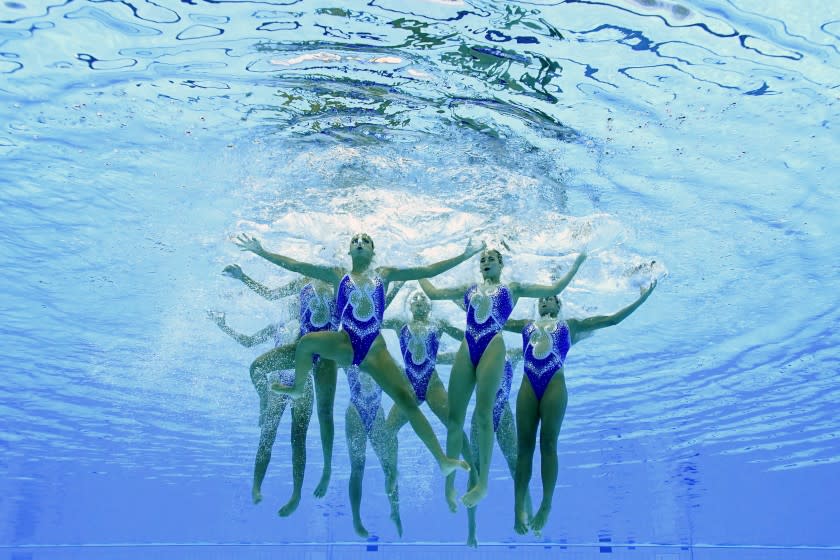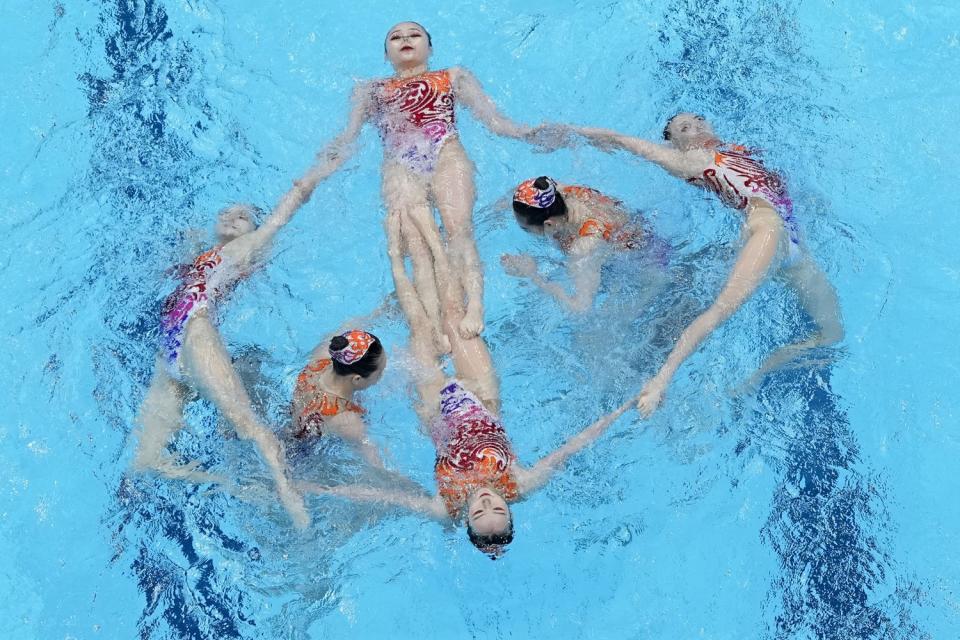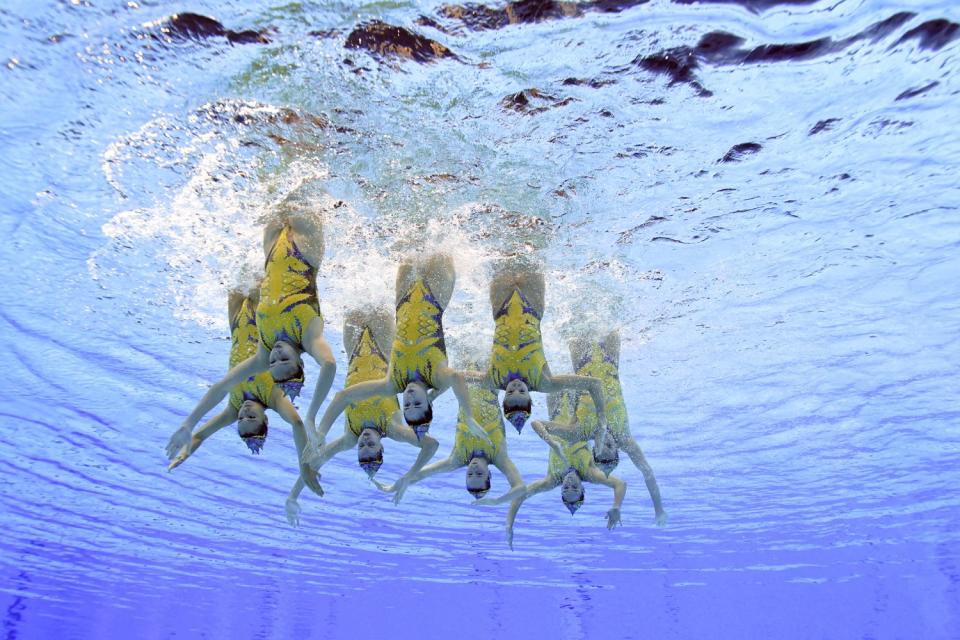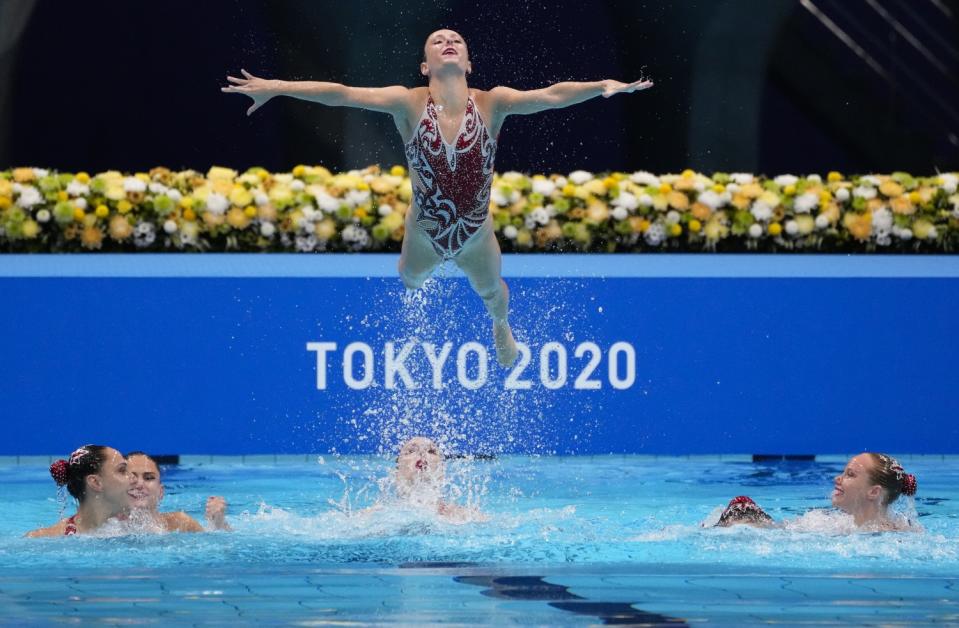Can you sprint while holding your breath? Artistic swimmers defend their Olympic sport

The artistry, if that’s what we’re calling it now, starts before the swimmers jump into the water.
Arms swing freely or move in rigid unison as part of the poolside walk, some swimmers pivoting on their heels and others on their toes in carefully choreographed movements. One group placed their hands on their hips, gyrating their bodies before forming a human pyramid.
In a matter of moments, the frivolous fun moves into the pool. Bodies corkscrew into the water, heads first, legs scissoring furiously through the air. A swimmer is vaulted out of the water by her teammates, pirouetting back toward a massive splashdown. Arms slice through the air in short, rhythmic bursts.
Call it artistic. Call it athletic. Call it mesmerizing.
Just don’t call it synchronized.

Pushing back at widespread mockery surrounding the sport long known as synchronized swimming, officials rebranded it as artistic swimming before these Tokyo Olympics, explaining that it would broaden its popularity and make it more appealing to sponsors and television executives.
“Synchronized swimming is looked at from the outside world as water ballet, still, by some people,” Amie Thompson, co-captain of the Australian team, said Saturday night during the finals of the team routine at the Tokyo Aquatics Centre. “A lot of people don’t know how difficult it is, so I think trying to shift away from that is an important thing for our sport to move forward, and that’s what they’ve been trying to do with the name change.”
Audrey Joly of the Canadian team said the name change puts artistic swimming on par with artistic gymnastics, commanding additional respect. The sport requires not only precise movements executed in unison but also strength and stamina that can border on the extraordinary.
While most swimmers usually hold their breath for about 20 seconds at a time as part of their routines while inverted underwater, Canada’s Jacqueline Simoneau said she’s capable of holding hers for 5 minutes, 11 seconds.
“A lot of people compare it to a sprint, doing a running sprint on track but like holding your breath while you do it,” Joly said, “so that’s why I think it’s really hard because it builds up the lactic acid in your body, but you have to keep going and you have to smile while you do it.”

Back when it was known as synchronized swimming, the sport was famously parodied on “Saturday Night Live.” A hairy-chested Harry Shearer and a life vest-wearing Martin Short — “I don’t swim,” he explained — posed as brothers who were training for the 1988 Olympics even though it had never been sanctioned as a men’s event. (That remains the case.)
Christopher Guest played their choreographer, chiding Shearer for overzealously jabbing his finger toward his partner.
“No, you’re not angry at him,” Guest said, “you’re just pointing at him.”
Reflecting its continued status as a niche sport more than 30 years after the airing of that skit, the rules were displayed on the video board before the competition. Team routines last up to four minutes, the judges placing a premium on acrobatics and athleticism displayed by the eight swimmers. Poolside walks do not figure into the scores, but teams can be penalized for going over a 30-second limit.
“Human motion becomes underwater art,” read the closing catchphrase on the video board.

That artistry requires more than shiny headpieces, nose clips, massive globs of gelatin to keep one’s hair in place and swimsuits tailored to a theme such as Australia’s nod to “Avatar: The Last Airbender.”
“We’re looking at music that comes from the waterbender and the firebender, so this side is the fire and this side is the water,” Thompson said, pointing alternately to the red on one side of her sequined swimsuit and blue on the other. “We had a mixture of strong music and soft music and the strong music was when we were trying to reflect the power that fire can have and the soft music was the grace of water.”
The Russian Olympic Committee continued its dominance with a sixth consecutive team championship, giving Svetlana Romashina a record seventh gold medal in the sport during what the 31-year-old said would be her final Olympics. China won silver and Ukraine bronze. (The United States did not have an entrant in the team routine.)
The outcome provided some symmetry for a sport in transition.
“We are the first Olympic medalists in artistic swimming,” the ROC’s Vlada Chigireva said, “and we are the last Olympic medalists in synchronized swimming.”
This story originally appeared in Los Angeles Times.

